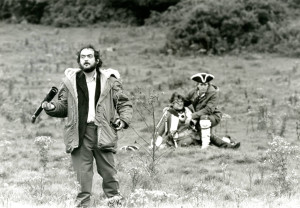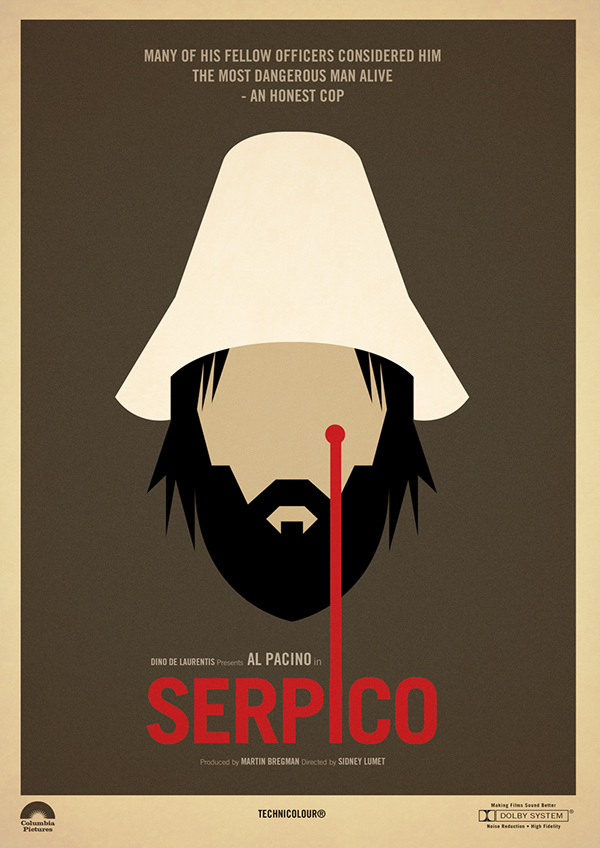Celebrating one of my favorite movies, Serpico, I wrote the following:
I want—and need—to revisit this movie on an annual basis, because it satisfies many needs. One, it’s a masterpiece, so there’s that. Two, it reminds me many things I need to know, about the world and myself. And most of all, it’s a rallying cry against conformity and cowardice; a stark reminder of how much we’re capable of and how little we typically do. I watch it and think: I want to be that guy. I know I can’t be that guy, so it’s the least I can do to watch, learn and emulate.
Confession: there are dozens of movies I watch at least once each year. And there are certain movies I may watch two times, every year. (Walkabout, Red, Burnt by the Sun, The Conversation, Blade Runner, The Thing, Bottle Rocket, Five Easy Pieces, Taxi Driver, They Live, and many more.)
To a certain, superficial extent, it’s something many men do. Male friends can sit around and recite movie dialogue, literally for hours. For certain types of men, watching sports (without speaking) or “talking” via classic or obscure movie scenes not only counts as communication, it’s a form of genuine bonding that can’t be approximated by mereintimacy. It’s at once a shout-out and its own kind of authentic language.
Many years ago, when I waited tables, there was a bartender who liked the cut of my jib, and the feeling was reciprocal. I’m not exaggerating when I say that we conversed almost entirely in dialogue from Caddyshack over the course of a hot, lucrative, and wonderful summer. I don’t just mean that we ceaselessly quoted lines at each other; I mean we used lines from that ultimate male-bonding movie to fit the particular situation. We bended Caddyshack to our will in order to keep the vibe alive. To some people this would, understandably, seem juvenile at best and a waste of human potential at worst; to others (invariably, all masculine) this signifies a high level of improvisatory brilliance, the pinnacle of boys being boys. I still look back on that summer, and our commitment to inspired inanity, with a certain amount of awe. I guess you had to be there.
A cinema junkie’s compulsion? Certainly. But it’s more than that. As a writer, I not only want to savor, but watch and study the craft: Why does this work? How did that happen? Who else could (or couldn’t) do this? What is it that makes me come back to this, stirred the way the tides are moved by the moon? It is, of course, never quite the same experience after it’s been seen the first time, but the very best films warrant repeated viewings so that fresh nuances and details emerge, allowing a deeper understanding and appreciation to accrue.

Some of this is due to the inexorable passage of time, which can augment our appreciation of how difficult (or, at least how analog) the creation of film once was. So, for instance, when I watch any of the elaborate set pieces from Kubrick’s Barry Lyndon, I can at once appreciate the splendor on the screen (and reminisce about an era when leisurely shots were commonplace, and the patience of the audience implicit, although in fairness, Kubrick in general, and this film especially, demanded a great deal) as well as the meticulous work that went in to setting up that scene: the initial vision, revised and refined, choosing the most perfect or appropriate setting, the hours required putting actual human beings in place, the costumes, the human lack of “perfection”, etc. When, on the other hand, I watch even a few seconds of what passes for a contemporary action sequence, I’m distracted by the triumph of digital innovation and the bizarre combination of laziness and proficiency it yields, and instead of seeing a sweaty, megalomaniacal director orchestrating set pieces, I see a Frito-fingered nerd bent over a laptop, using a mouse and the latest programming to make the artifice more artificial.
Usually, my motivation to rewatch (and watch, again) a movie is more practical. I’m taking notes, I’m seeking inspiration, I’m trying to figure out how the magic was made the way only repeated viewings (like repeated readings) make possible. Also, listening to albums or watching movies is a matter of hours, not the weeks (or months) revisiting favorite books might entail in an already harried existence.
I have a friend and fellow cinephile whose taste I trust. She’s confounded by my compulsion to revisit, just as I admire her insatiable need to discover the next new thing. Our perspectives are irreconcilable: while I’m content allowing consensus to emerge (as a result of this, I tend to read more reviews than books, and read about more movies and music than I experience, a bittersweet consequence of our ceaseless state of info-overload), she often seeks an immediate, unfettered experience. More, she believes I’m somehow marring my initial, enduring impressions by returning to them, sort of like an aesthetic scab I’m compelled to pick. Naturally, I disagree, and imagine my devotion is a sincere token of approbation—a gesture of deification without the abasement of, say, organized religion.
There is, certainly, a ritualistic element. We compulsive re-watchers are not unlike the once-faithful, who still attend holiday mass once per year, equal parts routine and OCD. Except our faith has never faltered; if anything, it’s augmented by these annual occasions, equal parts pilgrimage and consecration. I suspect I’m not the only sap, too sentimental by half, who can only watch certain movies during certain seasons. Bull Durham and Jaws are only appropriate for the dogged days of summer, while The Godfather and, say, The French Connection, almost oblige late afternoon on a winter’s day. Certain masterpieces can accommodate frigid or sweltering conditions: Dr. Strangelove and The Big Lebowski, for instance, lose little morning, noon, or evening in November or May.
But mostly, it’s all a matter of enjoyment.
Can anyone, for instance, ever overdose on a scene like Jake Gittes, sitting patiently at the top of a sloping cliff, overlooking the Los Angeles coastline as day slides into evening; lighting cigarette after cigarette, totally unaware he’s already stumbled into a hornet’s nest of corruption (Chinatown)? Or Harry Caul, having heard his own apartment bugged, reducing his floors and walls to splinters in a fruitless attempt to find the hidden microphone (The Conversation)? Or Butch and Sundance running into the final hail of bullets they’ll ever face (Butch Cassidy and the Sundance Kid)? Or the pitiful Stroszek, on a ski lift holding a frozen turkey while beneath him, in coin-operated cages, a chicken dances to the ebullient harmonica woops of Sonny Terry (Stroszek)? Or the Aborigine performing his ritualistic courting dance to the oblivious young woman whose life he saved (Walkabout)? Or Terry, fighting Johnny Friendly for his brother, himself, and the soul of the waterfront (On the Waterfront)? Or Roy Batty, “more human than human”, saving the blade runner’s life, and delivering his “tears in rain” soliloquy (Blade Runner)?
Stop me before I allude again… The answer, of course, is never, for all the above, and many, many more. It can, at times, be complicated to explain, but the reality could scarcely be simpler. We watch and re-watch because we want to, because we have to. And for any happy, hopeless soul who gets emotional about the movies that move them, it seems some type of annual ceremony is the least we can do for these kindred spirits and would-be allies who have expanded and, on occasion, saved our lives.
*This essay originally published in PopMatters on 8/21/18.

